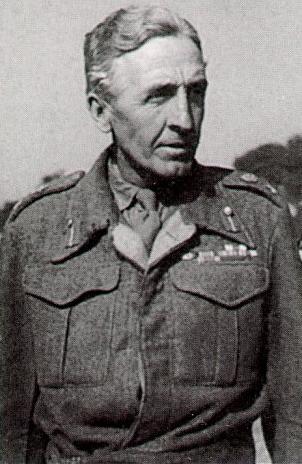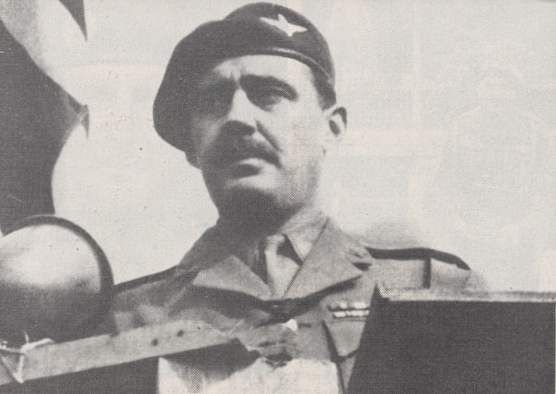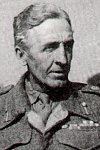In the Wake of the Victors
Another chapter from Our Own Correspondent's impressions of his visit to the British Front
By Captain Norman MacMillan, M.C., A.F.C.
The War Illustrated, Volume 9, No. 206, Page 3-4, May 11, 1945.
Many of the roads in Belgium and Holland are surfaced with stone, cut in the shape of cubes and laid close together, without mortar or cement, on top of the levelled soil. Such roads stand up reasonably well to normal traffic, but they were subjected to terrific strain by the enormous mechanized convoys that poured in unending succession towards the Front. The severe frost had frozen the water in the soil beneath them and the expanding ice had thrown the stone sets upward; when the thaw came the weight of traffic destroyed the surface. Wherever we went, we found stretches of road under repair, causing the flow of traffic to slow down at one-way bottlenecks.
American and British white troops and darkies worked on the roads. It was hard, unremitting toil, whether the surfaces were of pavé or of clay and broken stone. The pavé had to be reset accurately; macadam and dirt roads were resurfaced with the debris of shattered buildings, where these were at hand. I cannot say that the men engaged on this work looked happy. Most were miserable expressions, especially the white Americans. Here was no glory, no fame, but disillusionment arising from realization of the chores of war. Yet there was honour in the sweaty toil, for without it the all-important convoys could not go through to their destination.
By day and night we passed lines of amphibious vehicles: buffaloes, 8-wheeled naval ducks, 6-wheeled army ducks; followed and preceded by supply transport and armour of all kinds, wherever possible moving up in a double row, for the great assault on the Rhine barrier. By day, vehicles on urgent priority used blinking red lights to distinguish them and give them right of way. At night, headlights blazed, dipped to ours, then blazed again as they passed. But one long convoy of amphibious craft, on urgent call, moved lightless through the night; military traffic police stopped all transport going the other way and warned the drivers to turn off their headlights to avoid dazzling the drivers of the oncoming amphibians.
Tree-trunk Sings Warn Drivers
Traffic Control utilized almost every roadside tree-trunk to display instructions and warnings to drivers. The more important signs were repeated every few miles. Roads were code-named or numbered, and the words UP or DOWN distinguished direction to or from the front. One road might be 305 DOWN; another MAPLE LEAF DIAMOND UP. Tanks or heavy trucks were scheduled to a speed limit over soft or worn roads. Sometimes all traffic had to be speed restricted, as at approaches to temporary bridges where single line traffic was compulsory.
Many signs, painted in black letters on large white boards, were repeated every few miles. Among them were IF YOU MUST STOP GET OFF THE ROAD ... IF YOU CAN'T GET OFF THE ROAD DON'T STOP ... THE CAREFUL DRIVER HAS NO REGRETS ... NO DOUBLE BANKING ... DON'T OVERTAKE IN FOG ... OBEY THE SIGNS AND HELP TRAFFIC CONTROL ... VEHICLES MUST KEEP THIRTY YARDS APART ... NO OVERTAKING. And on one tree-trunk. I CAN'T THINK OF ANYTHING TO PUT ON THIS ONE. In the front zones the signs became less official in tone. Two I noticed were inscribed on white cardboard nailed to convenient tree-trunks, south of the Reichswald Forest, where at that time the 51st (Highland) Division was in action. They read:
Drive on the verges
And break up the route,
We'd sure like to give you
A kick with our boot.
Wave at the girls
To help your nerves,
But remember the road
Has dangerous curves.
In the towns, traffic signposts to indicate the location of units headquarters looked like totem poles. They were covered from top to street-level with little plates of diverse colours, signs, queer letters, and abbreviated names, and when the face of the post was filled more plates were mounted on the sides until the indicator looked like a brilliantly coloured scaly, tropical animal. Everywhere prominent among the signs were the Maple Leaf and the Scottish Lion.
We stopped for a few minutes in 'S-Hertogenbosch (it means Duke's Wood) to see the magnificent Gothic cathedral, much less damaged than some of our English cathedrals; indeed, almost unhurt. The interior, which reminded me of Milan cathedral, felt damp and cold. There was no heating. But a number of worshipers knelt in the quiet building, most of them in the chapels alongside the choir and altar, intent upon their devotions, while outside the dull boom of U.S. “Long Tom” guns of big calibre broke the silence with the reminder that war waged over the land. When returned to the car, Dutch children ran up to ask us if we were Canadians.
Before we reached the Grave bridge – protected by light A.A. – a flying bomb flew past us at about 1,500 feet, its roar sounding above that of the traffic. Throughout Holland the Bailey bridge was almost the most conspicuous feature of the landscape. This prefabricated bridge must have saved immense labour and much time during the advance over a countryside so cut by waterways. (See page 564, Vol. 8.) We crossed the Maas-Wahl canal by Bailey bridge, and entered Nijmegen, where a fair-haired, curly-topped Dutch girl of about five stood on a chair in a window watching the traffic and singing at the top of her voice.
We pushed on towards the forward zone, and after traversing an appalling road of and mud reached the main road to Krannenburg, a small town eight miles from Nijmegen and the railway frontier station within Germany. It had been captured the previous evening by the H.L.I. Medium bombers of the 2nd T.A.F. had softened up for the attack, bombing both sides of the Nijmegen-Krannenburg road where defence points were sited. In a length of several miles I found only one bomb crater on the road itself, evidence of remarkable accuracy of aim despite poor visibility. This one crater was being filled in by Pioneers, to restore the roadway which was there reduced to one-way traffic.
The Jerrican Cooking-Stove
Before reaching Krannenburg I saw two undamaged German frontier radiolocation towers – of an early pattern – apparently anti-aircraft radar posts. Krannenburg was badly smashed up by the guns, bombs and rockets of the Typhoon squadrons. I went into a doctor's house. On one side of the lobby was his waiting-room, opposite was his surgery. Behind was his combined dining-room and lounge. A picture frame hung on one wall, but the picture it had contained was out of the frame. Tables were overturned, windows smashed, plaster gone; books lay about the floor and sideboard. The house looked as if a gigantic impish child had been let loose in it. Yet it had every appearance of having been lived in until the bombardment began a few hours before.
Krannenburg, with a pre-war population of just under 4,000, has considerable remains of ancient ramparts, and near it were the newer ones of the Siegfried Line. Its 13th-century church had an attractive tall steeple, but the sky showed through a few war-made holes in it. On a plot of open ground facing the main street some troops sat on wooden chairs brought out from the houses, cooking their rations on a petrol fire that burned in a torn-open jerrican; the thought struck me that last time I warmed myself at such a fire was on the Transjordanian desert, east of the Dead Sea; here it was in a dead town, through which poured a never-ending stream of armoured and unarmoured vehicles.
We drove on to the beginning of the Siegfried defence system, and then walked forward. The road was camouflaged from the farther bank of the Rhine – five miles away, on the other side of floods that lapped to the edge of the road – by cut branches of fir trees placed between the trunks of the trees that grew in an avenue along the verges. The main German position was visible on the wooded slopes ahead, and for some way back the road was open to enemy observation.
I could hear our bombers passing high above the clouds. Austers spotted amid flak. I saw the tank crews stiffen and look up. Two specks grew swiftly in the eastern sky. I recognized them quickly. “Spits”, I said. Simultaneously the tank crews knew them. “Good thing, too!” they said, What a target that road was for fighter bombers! If the enemy had possessed air superiority it would have been impossible to use it as it was being used.
At the first anti-tank ditch of the Siegfried Line we met Lieut.-Gen. B. G. Horrocks, the 30th Corps Commander, inspecting the position. I asked him for a message for readers of The War Illustrated. He hesitated. But when I told him the articles could not possibly appear for several weeks, he realized that security questions could not be endangered, as they sometimes are by quick publication of messaged which may be useful to the enemy. And General Horrocks said: “Our soldiers have fought magnificently against considerable opposition. We have definitely broken through now. Our trouble is roads and communications. Yesterday we bulldozed over the country” - he waved one arm towards the land that lay behind us to the right of the road. “I won't say that we won't have our little set-backs, but we should be all right.” Events have proved his forecast, made at the opening of the Rhine offensive, to be correct.
Previous and next article from Seeing the War at First Hand
How the Tide of Battle Swept into Germany
I visited a R.A.F. Casualty Air Evacuation Unit in Belgium that was formed in November 1944. Commanding it is Wing Commander J. Clarke Taylor, graduate of Glasgow University, a R.A.F. regular M.O. The
My Visit to Wartime Holland
Control of the waterways is so important in Holland that a Government minister of public works (Waterstaat) is responsible for this feature of Dutch life, and each district in Holland has its own wate
Index
Previous article
How the Tide of Battle Swept into Germany
I visited a R.A.F. Casualty Air Evacuation Unit in Belgium that was formed in November 1944. Commanding it is Wing Commander J. Clarke Taylor, graduate of Glasgow University, a R.A.F. regular M.O. The
Next article
My Visit to Wartime Holland
Control of the waterways is so important in Holland that a Government minister of public works (Waterstaat) is responsible for this feature of Dutch life, and each district in Holland has its own wate






